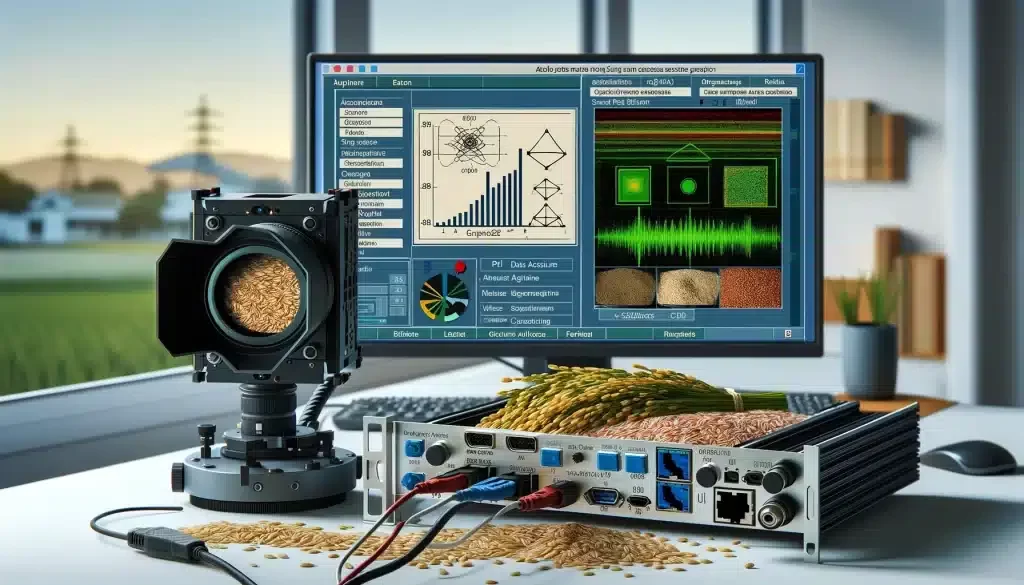Rice Color Sorting Algorithm Based On Color Linear Array Ccd
Explore advanced data acquisition and processing for rice sorting using PCI cards, CCD cameras, wavelet filtering, and K-means clustering.
PCI data acquisition card and color linear array CCD camera are used to collect linear array image data of the measured object, and the collected data are stored in the form of text documents as a data source for subsequent research on color sorting algorithms. In order to reduce the interference of high-frequency noise, try to use wavelet filtering to obtain a smooth signal. According to the relevant theories of feature extraction in digital image processing, combined with the characteristics of actual image data, the K-means cluster analysis method is used to classify the image data. Divided into background type, normal rice type and heterochromatic rice type. A rice color sorting algorithm based on color linear array CCD is implemented, and the algorithm does not rely on human experience. ª¥
Introduction to Advanced Data Acquisition System
In today’s advanced technological landscape, precision in data acquisition and processing is pivotal for industries such as agriculture, where it ensures quality and uniformity in products such as rice. Utilizing a PCI data acquisition card paired with a color linear array CCD camera marks a significant step forward in collecting high-fidelity image data of objects under examination. This setup is primarily used to gather linear array images of rice grains, which are then meticulously stored as text documents. These documents serve as a foundational data source for further exploration and refinement of color sorting algorithms.
Overcoming Noise with Wavelet Filtering
The main challenge in processing this image data is the presence of high-frequency noise, which can significantly degrade the quality of the information extracted. To combat this, wavelet filtering is employed to smooth the signal, effectively reducing noise while preserving important features of the image data. This method not only improves the accuracy of the data but also enhances the performance of subsequent analytical processes.
Feature Extraction in Image Data Processing
Digital image processing encompasses a variety of techniques for feature extraction, a fundamental step in interpreting and analyzing image data. By integrating these theoretical concepts with the practical characteristics observed in the rice images, a more tailored approach can be adopted for analyzing this specific type of data. Among the various techniques available, the K-means clustering algorithm is chosen for its efficacy in grouping data into coherent clusters without relying on predefined labels.
In the context of the collected rice grain images, the K-means algorithm is utilized to categorize the grains into three distinct types: background, normal rice, and heterochromatic rice. This classification is crucial for enabling the automation of color sorting, a process traditionally reliant on human visual inspection. By automating this step, the approach reduces labor costs and subjective errors, leading to more consistent product quality.
Application of K-means Clustering in Rice Sorting
The implementation of a rice color sorting algorithm, based on the data obtained from the color linear array CCD camera, represents a significant advancement in the field. One of the notable features of this algorithm is its independence from human experience, which signifies a shift towards more objective, data-driven decision-making processes in agricultural production. This algorithmic approach allows for adjustments and learning based on actual operational data, rather than predefined expectations, which can vary between operators.
Implementation and Benefits of Automated Color Sorting
Overall, the integration of PCI data acquisition technologies with sophisticated image processing and machine learning algorithms like K-means provides a robust framework for enhancing agricultural sorting and quality control processes. This method not only streamlines operations but also ensures higher accuracy and efficiency in sorting grains by color, which is vital for meeting both consumer expectations and regulatory standards. Such advancements underscore the potential of digital technologies to transform traditional agricultural practices into more efficient, modernized systems.
For futher details of this article and research, feel free to contact our team for assistance.
Original research was done by Wen Qiang, Hu Mingming, Sang Nan
About ETprotein:
ETprotein, a reputable plant protein vegan protein Chinese factory manufacturer and supplier, is renowned for producing, stocking, exporting, and delivering the highest quality organic bulk vegan protein and plant proteins. They include Organic rice protein, clear rice protein, pea protein, clear pea protein, oat protein, watermelon seed protein, pumpkin seed protein, sunflower seed protein, mung bean protein, peanut protein, various of plant peptides etc. Their offerings, characterized by a neutral taste, non-GMO, allergen-free attributes, cater to a diverse range of industries. They serve nutraceutical, pharmaceutical, cosmeceutical, veterinary, as well as food and beverage finished product distributors, traders, and manufacturers across Europe, USA, Canada, Australia, Thailand, Japan, Korea, Brazil, and Chile, among others.
ETprotein specialization includes exporting and delivering tailor-made protein powder and finished nutritional supplements. Their extensive product range covers sectors like Food and Beverage, Sports Nutrition, Weight Management, Dietary Supplements, Health and Wellness Products, and Infant Formula, ensuring comprehensive solutions to meet all your protein needs.
As a trusted company by leading global food and beverage brands and Fortune 500 companies, ETprotein reinforces China’s reputation in the global arena. For more information or to get a free sample of their protein products, please contact them and email sales(at)ETprotein.com today.












